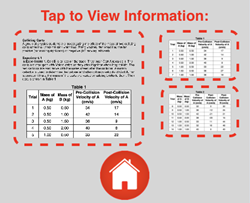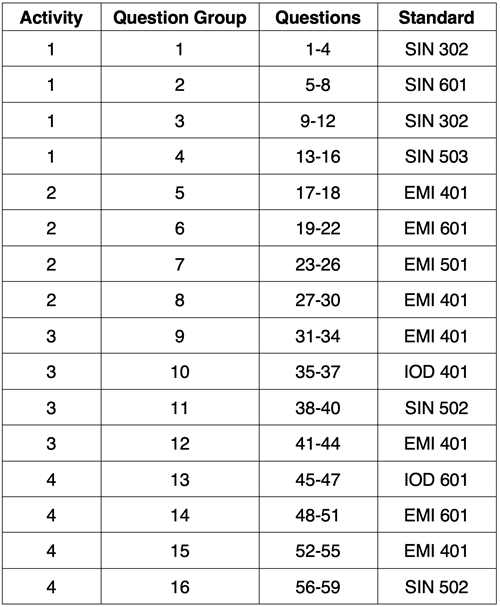About the Science Reasoning Center
 Highly Recommended
Highly RecommendedLike all our Science Reasoning Center activities, the completion of the Colliding Carts activity requires that a student use provided information about a phenomenon, experiment, or data presentation to answer questions. This information is accessible by tapping on the small thumbnails found on the bottom right of every question. However, it may be considerably easier to have a printed copy of this information or to display the information in a separate browser window. You can access this information from this page.
The Standards
The Colliding Carts activity describes a set of two experiments exploring the effect of cart mass upon the post-collision velocity of two carts on a track. Data is presented in the form of two different data tables. The activity requires that students understand the design, recognize the effect of one variable on another, recognize patterns associated with mass ratios and velocity ratios, extrapolate from the provided data in order to predict the result of conducting additional trials, and identifying a general equation that fits a specific set of data. Success with the activity requires some degree of understanding or proficiency with respect to ...
- Asking Questions and Defining Problems (Science and Engineering Practice 1.3)
Ask questions to determine relationships, including quantitative relationships, between independent and dependent variables. - Developing and Using Models (Science and Engineering Practice 2.6)
Develop and/or use a model (including mathematical and computational) to generate data to support explanations, predict phenomena, analyze systems, and/or solve problems. - Planning and Carrying Out Investigations (Science and Engineering Practice 3.5)
Make directional hypotheses that specify what happens to a dependent variable when an independent variable is manipulated. - Analyzing and Interpreting Data (Science and Engineering Practice 4.1)
Analyze data using tools, technologies, and/or models (e.g., computational, mathematical) in order to make valid and reliable scientific claims. - Analyzing and Interpreting Data (Science and Engineering Practice 4.5)
Evaluate the impact of new data on a working explanation and/or model of a proposed process or system. - Using Mathematics and Computational Thinking(Science and Engineering Practice 5.6)
Apply ratios, rates, percentages, and unit conversions in the context of proposed solutions to an engineering design problem, complicated measurement problems involving quantities with derived or compound units (such as mg/mL, kg/m3 , acre-feet, etc.). - Patterns (Crosscutting Concept 1.1)
Different patterns may be observed at each of the scales at which a system is studied and can provide evidence for causality in explanations of phenomena. - Scale, Proportion, and Quantity (Crosscutting Concept 3.2)
Algebraic thinking is used to examine scientific data and predict the effect of a change in one variable on another (e.g., linear growth vs. exponential growth). - Stability and Change (Crosscutting Concept 7.1)
Much of science deals with constructing explanations of how things change and how they remain stable.
While the Colliding Carts activity addresses the six NextGen Science and Engineering Practices and the three Crosscutting Concepts above, the activity drew its greatest inspiration from ACT's College Readiness Standards for Science Reasoning. The activity consists of 59 questions organized into 16 Question Groups and spread across the four activities. All three strands (Interpretation of Data - IOD; Science Investigation - SIN; and Evaluation of Models, Inferences, and Experimental Results - EMI) of the College Readiness Standards are addressed in this activity. The code given for the standard includes three letters to indicate the strand and three numbers to indicate the specific standard within that strand. Higher numbers are indicative of more complex science reasoning skills. The relationship between the questions and the standards is as follows:

Complementary and Similar Resources
The following resources at The Physics Classroom website complement the Colliding Carts Science Reasoning Activity. Teachers may find them useful for supporting students and/or as components of lesson plans and unit plans.
Physics Classroom Tutorial, Momentum and Its Conservation Chapter: Momentum Conservation Principle
Physics Video Tutorial, Momentum, Collisions, and Explosions: Action-Reaction and the Law of Momentum Conservation
Physics Interactives, Momentum and Collisions: Collision Carts Simulation
Physics Interactives, Momentum and Collisions: Fish Catch Simulation
Physics Interactives, Momentum and Collisions: Exploding Carts Simulation
Concept Builders, Momentum and Collisions: Law Enforcement - Explosions
Concept Builders, Momentum and Collisions: Law Enforcement - Hit and Stick Collisions
Concept Builders, Momentum and Collisions: Keeping Track of Momentum - Hit and Stick Collisions
Minds On Physics, Momentum and Collisions Module, Missions MC-MC10
The Calculator Pad, Momentum and Collisions Chapter, Problem Sets MC6 - MC10
Recommended: Print Passage, Tables, and Graphs
Also see: